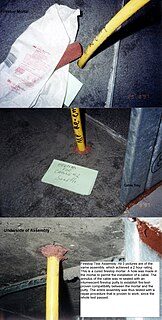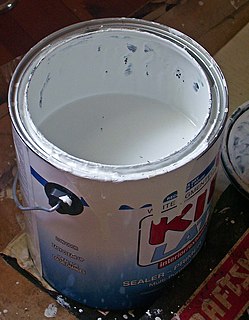Related Research Articles

Acrylic paint is a fast-drying paint made of pigment suspended in acrylic polymer emulsion. Acrylic paints are water-soluble, but become water-resistant when dry. Depending on how much the paint is diluted with water, or modified with acrylic gels, mediums, or pastes, the finished acrylic painting can resemble a watercolor, a gouache or an oil painting, or have its own unique characteristics not attainable with other media.

Paint is any pigmented liquid, liquefiable, or mastic composition that, after application to a substrate in a thin layer, converts to a solid film. It is most commonly used to protect, color, or provide texture to objects. Paint can be made or purchased in many colors—and in many different types, such as watercolor or synthetic. Paint is typically stored, sold, and applied as a liquid, but most types dry into a solid.

Woodworking is the activity or skill of making items from wood, and includes cabinet making, wood carving, joinery, carpentry, and woodturning.

Varnish is a clear transparent hard protective finish or film. Varnish has little or no color and has no added pigment as opposed to paint or wood stain which contains pigment. However, some varnish products are marketed as a combined stain and varnish. Varnish is primarily used in wood finishing applications where the natural tones and grains in the wood are intended to be visible. It is applied over wood stains as a final step to achieve a film for gloss and protection. Varnish finishes are usually glossy but may be designed to produce satin or semi-gloss sheens by the addition of "flatting" agents.

Wood carving is a form of woodworking by means of a cutting tool (knife) in one hand or a chisel by two hands or with one hand on a chisel and one hand on a mallet, resulting in a wooden figure or figurine, or in the sculptural ornamentation of a wooden object. The phrase may also refer to the finished product, from individual sculptures to hand-worked mouldings composing part of a tracery.

Linseed oil, also known as flaxseed oil or flax oil, is a colourless to yellowish oil obtained from the dried, ripened seeds of the flax plant. The oil is obtained by pressing, sometimes followed by solvent extraction. Linseed oil is a drying oil, meaning it can polymerize into a solid form. Owing to its polymer-forming properties, linseed oil can be used on its own or blended with combinations of other oils, resins or solvents as an impregnator, drying oil finish or varnish in wood finishing, as a pigment binder in oil paints, as a plasticizer and hardener in putty, and in the manufacture of linoleum. Linseed oil use has declined over the past several decades with increased availability of synthetic alkyd resins—which function similarly but resist yellowing.
A cutting or chopping board is a durable board on which to place material for cutting. The kitchen cutting board is commonly used in preparing food; other types exist for cutting raw materials such as leather or plastic. Kitchen cutting boards are often made of wood or plastic and come in various widths and sizes. There are also cutting boards made of glass, steel, or marble, which are easier to clean than wooden or plastic ones such as nylon or corian, but tend to damage knives due to their hardness. Rough cutting edges—such as serrated knives—abrade and damage a cutting surface more rapidly than do smooth cutting implements.

Putty is a material with high plasticity, similar in texture to clay or dough, typically used in domestic construction and repair as a sealant or filler.
Walnut oil is oil extracted from walnuts, Juglans regia. The oil contains polyunsaturated fatty acids, monounsaturated fatty acids, and saturated fats.

Wood Stain is a type of paint used to color wood.

A primer or undercoat is a preparatory coating put on materials before painting. Priming ensures better adhesion of paint to the surface, increases paint durability, and provides additional protection for the material being painted.

French polishing is a wood finishing technique that results in a very high gloss surface, with a deep colour and chatoyancy. French polishing consists of applying many thin coats of shellac dissolved in denatured alcohol using a rubbing pad lubricated with one of a variety of oils. The rubbing pad is made of absorbent cotton or wool cloth wadding inside of a piece of fabric and is commonly referred to as a fad, also called a rubber, tampon, or muñeca.

Wood finishing refers to the process of refining or protecting a wooden surface, especially in the production of furniture where typically it represents between 5 and 30% of manufacturing costs.
Painterwork accomplishes two things, namely the preservation and the coloration of the material which is painted. The compounds used for painting, taking the word as meaning a thin protective and/or decorative coat, are very numerous, including oil paint of many kinds, distemper, whitewash, tar; but the word paint is usually confined to a mixture of oil and pigment, ground together in a process that thoroughly coats every small particle of pigment in oil, together with other materials which possess properties necessary to enable the paint to dry hard and with a degree of flexibility and to varying degrees of opacity/translucency. Oil paints are made up of four parts, the base, the vehicle, the solvent and the driers. Pigment may be added to these to obtain a paint of any desired color. There are several bases for oil paint, those most commonly used for building work being white lead, red lead, zinc white and iron oxide.
Rotten stone, sometimes spelled as rottenstone, also known as tripoli, is fine powdered porous rock used as a polishing abrasive for metalsmithing and in woodworking. It is usually weathered limestone mixed with diatomaceous, amorphous, or crystalline silica. It has similar applications to pumice, but it is generally sold as a finer powder and used for a more glossy polish after an initial treatment with coarser pumice powder. Tripoli particles are rounded rather than sharp, making it a milder abrasive.
Wood putty, also called plastic wood, is a substance used to fill imperfections, such as nail holes, in wood prior to finishing. It is often composed of wood dust combined with a binder that dries and a diluent (thinner), and, sometimes, pigment. Pore fillers used for large flat surfaces such as floors or table tops generally contain silica instead of or in addition to wood dust. Pores can also be filled using multiple coats of the final finish rather than a pore filler.

Amish furniture is furniture manufactured by the Amish, primarily of Pennsylvania, Indiana, and Ohio. It is generally known as being made completely out of wood, usually without particle board or laminate. The styles most often used by the Amish woodworkers are generally more traditional in nature.
Mass finishing is a group of manufacturing processes that allow large quantities of parts to be simultaneously finished. The goal of this type of finishing is to burnish, deburr, clean, radius, de-flash, descale, remove rust, polish, brighten, surface harden, prepare parts for further finishing, or break off die cast runners. The two main types of mass finishing are tumble finishing, also known as barrel finishing, and vibratory finishing. Both involve the use of a cyclical action to create grinding contact between surfaces. Sometimes the workpieces are finished against each other; however, usually a finishing medium is used. Mass finishing can be performed dry or wet; wet processes have liquid lubricants, cleaners, or abrasives, while dry processes do not. Cycle times can be as short as 10 minutes for nonferrous workpieces or as long as 2 hours for hardened steel.

Tung oil or China wood oil is a drying oil obtained by pressing the seed from the nut of the tung tree. Tung oil hardens upon exposure to air, and the resulting coating is transparent and has a deep, almost wet look. Used mostly for finishing and protecting wood, after numerous coats, the finish can even look plastic-like. Related drying oils include linseed, safflower, poppy, and soybean oils. The oil and its use are believed to have originated in ancient China and appear in the writings of Confucius from about 400 BC. Raw tung oil tends to dry to a fine, wrinkled finish; the English name for this is gas checking; this property was used to make wrinkle finishes, usually by adding excess cobalt drier. To stop this, the oil is heated to gas-proof it, and most oils used for coating are gas-proofed, also known as "boiled".

Conservation and restoration of ceramic objects is a process dedicated to the preservation and protection of objects of historical and personal value made from ceramic. Typically this activity of conservation-restoration is undertaken by a conservator-restorer, especially when dealing with an object of cultural heritage. Ceramics are created from a production of coatings of inorganic, nonmetallic materials using heating and cooling to create a glaze. Typically the coatings are permanent and sustainable for utilitarian and decorative purposes. The cleaning, handling, storage, and in general treatment of ceramics is consistent with that of glass because they are made of similar oxygen-rich components, such as silicates. In conservation ceramics are broken down into three groups: unfired clay, earthenware or terracotta, and stoneware and porcelain.
References
- ↑ "Pore Fillers - Canadian Woodworking Magazine". www.canadianwoodworking.com. Retrieved 2018-08-06.
- 1 2 "Understanding Grain Fillers". Woodsmith. Des Moines, Iowa: August Home Publishing Co. 30 (179): 46–47. October 2008. ISSN 0164-4114. OCLC 4713102.
- 1 2 Simmons, Mac. "Filling wood grains with a paste wood filler". Amateur Woodworker. Archived from the original on 2008-06-30. Retrieved 2008-11-01.
- ↑ MacDonald, Nancy (2013). Woodworking. Cengage Learning. p. 896.
- 1 2 Finishes & Finishing Techniques . Taunton Press. 1999-11-01. pp. 13–16. ISBN 1-56158-298-0.